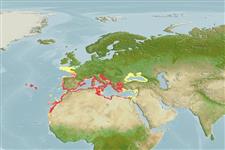Teleostei (teleosts) >
Perciformes/Serranoidei (Groupers) >
Serranidae (Sea basses: groupers and fairy basslets)
Etymology: Serranus: Latin, serran, serranus, saw and a fish of genus Serranus (Ref. 45335).
More on author: Linnaeus.
Environment: milieu / climate zone / depth range / distribution range
Ecology
Marine; demersal; depth range 5 - 150 m (Ref. 27000), usually ? - 30 m (Ref. 91154). Subtropical; 50°N - 16°N, 32°W - 42°E
Eastern Atlantic: Bay of Biscay to Mauritania (Ref. 5377), including the Canary, and Azores. Also from the Mediterranean and the Black Sea.
Length at first maturity / Size / Weight / Age
Maturity: Lm 17.3, range 16 - ? cm
Max length : 36.0 cm SL male/unsexed; (Ref. 5506); common length : 25.0 cm SL male/unsexed; (Ref. 5506); max. reported age: 16 years (Ref. 91154)
Found on rocky bottom and on Posidonia beds. Feed on fishes and crustaceans (Ref. 5506). Also found in muddy and algal or seagrass overgrown substrates. Reported to be a simultaneous hermaphrodite, which tends to spawn from early spring to early summer (Ref. 91154).
Tortonese, E., 1986. Serranidae. p. 780-792. In P.J.P. Whitehead, M.-L. Bauchot, J.-C. Hureau, J. Nielsen and E. Tortonese (eds.) Fishes of the north-eastern Atlantic and the Mediterranean. UNESCO, Paris. vol. 2. (Ref. 5506)
IUCN Red List Status (Ref. 130435)
Threat to humans
Harmless
Human uses
Fisheries: minor commercial; gamefish: yes
Tools
Special reports
Download XML
Internet sources
Estimates based on models
Preferred temperature (Ref.
123201): 15.1 - 21, mean 18.4 °C (based on 72 cells).
Phylogenetic diversity index (Ref.
82804): PD
50 = 0.5000 [Uniqueness, from 0.5 = low to 2.0 = high].
Bayesian length-weight: a=0.00977 (0.00830 - 0.01151), b=3.04 (3.00 - 3.08), in cm total length, based on LWR estimates for this species (Ref.
93245).
Trophic level (Ref.
69278): 3.8 ±0.3 se; based on diet studies.
Resilience (Ref.
120179): Medium, minimum population doubling time 1.4 - 4.4 years (K=0.22-0.24).
Fishing Vulnerability (Ref.
59153): Moderate vulnerability (44 of 100).
Nutrients (Ref.
124155): Calcium = 75.5 [30.7, 150.6] mg/100g; Iron = 0.921 [0.503, 1.748] mg/100g; Protein = 18.3 [16.5, 20.0] %; Omega3 = 0.4 [0.3, 0.7] g/100g; Selenium = 26.7 [14.2, 51.5] μg/100g; VitaminA = 19.7 [6.4, 69.4] μg/100g; Zinc = 0.772 [0.552, 1.131] mg/100g (wet weight);
